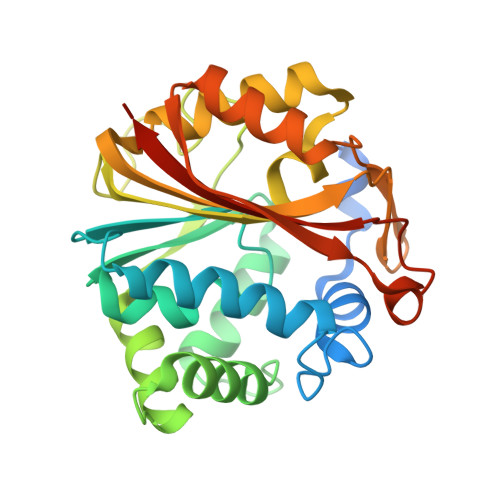Fragment-based screening by X-ray crystallography, MS and isothermal titration calorimetry to identify PNMT (phenylethanolamine N-methyltransferase) inhibitors.
Drinkwater, N., Vu, H., Lovell, K.M., Criscione, K.R., Collins, B.M., Prisinzano, T.E., Poulsen, S.A., McLeish, M.J., Grunewald, G.L., Martin, J.L.(2010) Biochem J 431: 51-61
- PubMed: 20642456
- DOI: https://doi.org/10.1042/BJ20100651
- Primary Citation of Related Structures:
3KPJ, 3KPU, 3KPV, 3KPW, 3KPY, 3KQM, 3KQO, 3KQP, 3KQQ, 3KQS, 3KQT, 3KQV, 3KQW, 3KQY, 3KR0, 3KR1, 3KR2 - PubMed Abstract:
CNS (central nervous system) adrenaline (epinephrine) is implicated in a wide range of physiological and pathological conditions. PNMT (phenylethanolamine N-methyltransferase) catalyses the final step in the biosynthesis of adrenaline, the conversion of noradrenaline (norepinephrine) to adrenaline by methylation. To help elucidate the role of CNS adrenaline, and to develop potential drug leads, potent, selective and CNS-active inhibitors are required. The fragment screening approach has advantages over other lead discovery methods including high hit rates, more efficient hits and the ability to sample chemical diversity more easily. In the present study we applied fragment-based screening approaches to the enzyme PNMT. We used crystallography as the primary screen and identified 12 hits from a small commercial library of 384 drug-like fragments. The hits include nine chemicals with two fused rings and three single-ring chemical systems. Eight of the hits come from three chemical classes: benzimidazoles (a known class of PNMT inhibitor), purines and quinolines. Nine of the hits have measurable binding affinities (~5-700 μM) as determined by isothermal titration calorimetry and all nine have ligand efficiencies of 0.39 kcal/mol per heavy atom or better (1 kcal≈4.184 kJ). We synthesized five elaborated benzimidazole compounds and characterized their binding to PNMT, showing for the first time how this class of inhibitors interact with the noradrenaline-binding site. Finally, we performed a pilot study with PNMT for fragment-based screening by MS showing that this approach could be used as a fast and efficient first-pass screening method prior to characterization of binding mode and affinity of hits.
Organizational Affiliation:
University of Queensland, Institute for Molecular Bioscience, Division of Chemistry and Structural Biology, Brisbane, Queensland 4072, Australia.
















